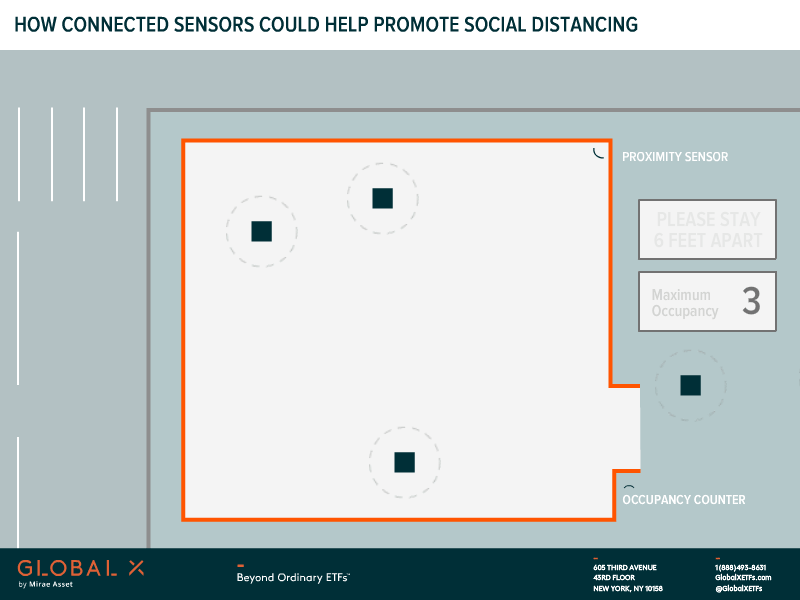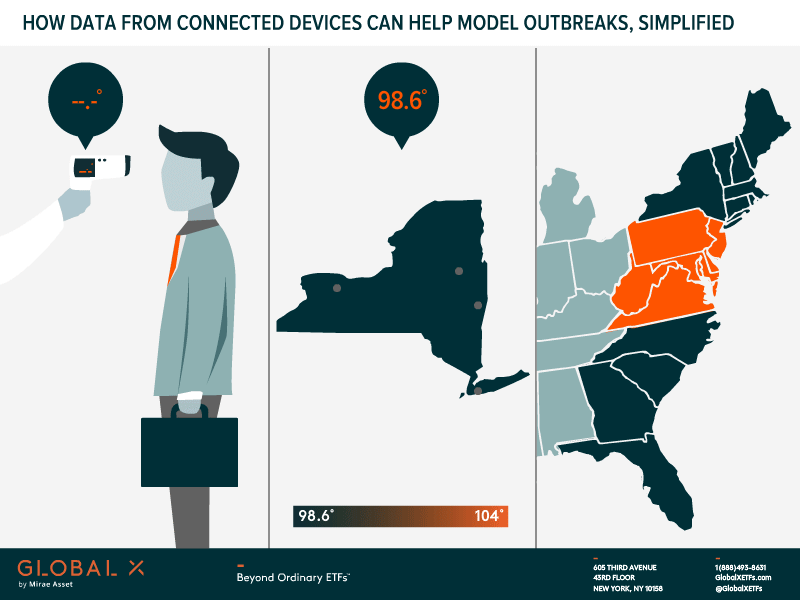The Internet of Things (IoT) refers to the billions of connected devices that can transmit and receive data over networks. For consumers, these devices range from home assistants and smart appliances to fitness trackers and cameras. In other settings, IoT solutions include connected medical devices, advanced industrial machinery/robotics, and smart infrastructure.
With the rapid growth of wireless networks, almost any device can become “smart” by embedding data-recording sensors and connectivity-enabling chips. While some critics questioned the value of this in the past, COVID-19 is revealing how IoT technologies can play a part in addressing a variety of today’s global issues.
Many of the fundamental benefits of IoT directly align with reopening and recovery. Wireless and autonomous technology can help reduce viral transmission. Data from connected devices can be a useful tool for surveillance and tracking. And IoT systems can help industries operate more seamlessly during times of uncertainty. In the following piece, we explore the powerful IoT use-cases implemented during the COVID-19 pandemic and how they might drive the theme’s growth moving forward.
Stopping the Spread
The virus that causes COVID-19, SARS-CoV-2, is one of the more contagious in recent history and can be transmitted via physical contact and through the air.1 IoT-based technologies that limit direct or indirect exposure to infected individuals are becoming commonplace:
- Contactless payment systems rely on near-field communication (NFC) chips to wirelessly make secure payments, eliminating the need for unhygienic physical cash exchanges. Digital payments company, CardFlight, reports weekly contactless payment volumes in September were up 164% on average, compared to the first week of March.2 Recent data points to this trend continuing. According to an August survey, 94% of retailers expect contactless payment volumes to increase over the next 18 months.3
- Connected cleaning robots and drones use wirelessly transmitted instructions to clean and disinfect physical spaces. Many of them are fully autonomous and rely on data exchanges to continually optimize and enhance their efforts. These machines are proving valuable during the pandemic, both by taking unhygienic tasks out of human hands and by enabling round-the-clock sanitation in high-risk settings like hospitals. One autonomous cleaning robot manufacturer noted that sales are up 100% since March, while a software developer in the space saw a 24% increase in autonomous robot usage during Q2.4 Separately, the NFL’s Atlanta Falcons deploys autonomous drones to disinfectant their stadium before and after games.5
- Proximity sensors within IoT systems record and transmit data about local environments and can help monitor social distancing. The NBA employs such technology to help individuals maintain social distance within their “bubble.” Many players and staff carry smart badges that measure proximity between people and alert wearers when social distance is broken.6 Similar technology is being rolled out in workplaces and at sporting events like the London Marathon.7 Sensors like STMicroelectronics’ FlightSense proximity sensors are essential to these devices’ functionality and are appearing in numerous solutions coming to market.8
Digital Surveillance
Disease surveillance and tracking is equally valuable to curbing the pandemic. By identifying infected individuals or hotspots, public health officials can act to limit further spread of COVID-19. IoT-enabled devices that use sensors to record and transmit health data can play a part in these efforts.
- Contact tracing can include the use of Bluetooth, Bluetooth Low Energy, and ultra-wideband technology to track the movements of infected individuals and identify others they may have encountered. Singapore’s government recently distributed wireless contact-tracing devices with plans to make them mandatory at high-risk public events.9 Similar utilization of this technology is occurring around the world, and often, contact tracing and proximity-sensing devices are one in the same. Many approaches also opt to use built-in smartphone functionality, rather than introducing a new device.
- Thermal imaging technology featured in connected devices uses infrared sensors to detect possible COVID-related symptoms and relay information to health professionals. Around the world, officials are using smart helmets with thermal imaging capabilities to take peoples’ temperatures and identify possible infections.10 Variations of this idea are also in the works. A Chinese startup developed eyeglasses with a built-in Qualcomm CPU that reportedly can measure up to 200 peoples’ temperatures from ten feet away in two minutes.11 Retrofitting autonomous drones and security systems with thermal imaging is also becoming common – one infrared camera manufacturer claims demand for their products is up 700%.12
- Health data gathered from connected devices can offer predictive diagnoses and useful public health insights. In May, Fitibit announced they were building an algorithm to analyze data from their connected health trackers to detect COVID-19 before symptoms started. After two months of study across 100,000 users, Fitbit found that they could detect almost 50% of COVID-19 cases a day before the onset of symptoms.13 Data from these kinds of devices can be valuable when viewed on the population level. Smart thermometers, for example, record temperature and location data and transmit it to centralized data repositories. Over time, and coupled with additional medical data, predictive models can estimate regional rates of disease transmission. One smart thermometer company reported collecting 14.8 million temperature readings from 650,000 individuals since March. From this data they developed a model that predicts state-level outbreak events 14 days in advance.14
Streamlining Systems
COVID-19’s impact goes beyond the sphere of public health and extends to the ways our businesses exist and operate. With much of the global economy shut down and workers confined to their homes at the onset of the pandemic, organizations grappled with how to continue their business operations. While some industries are relying on Cloud Computing to virtualize their workforces, others are leveraging IoT to help minimize business impacts while keeping employees safe.
- Industry 4.0 is the next generation of manufacturing and involves the industrial internet of things (IIoT), analytics, automation, and advanced manufacturing technologies. This technology gives manufacturers end-to-end operational visibility and better allocates workers, two benefits that became paramount when the pandemic threatened supply chains and labor forces. Organizations that embraced 4.0 were well-positioned to deal with these stresses, and those that weren’t are now re-evaluating their technology investments. A recent McKinsey survey of manufacturers sums up current industry sentiment: 90% plan on investing in talent for digitization, 39% have since implemented a central “control tower,” and almost 25% are accelerating automation efforts to compensate for labor shortages.15 Please see our blog, Theme Lab: A Look Inside An Amazon Fulfillment Center for an in-depth example of a business that employs 4.0 technologies.
- The Internet of Medical Things (IoMT) describes connected medical devices and applications within health care IT systems. IoMT devices like those in electronic intensive care units (eICUs) became useful tools for health care providers treating COVID-19 patients. eICUs contain myriad connected devices ranging from cameras, ventilators, and systems that track patient vitals, allowing doctors to monitor patients without risking infection.16 Health care provider sentiment toward telehealth services like eICUs highlights their newfound importance. Having surveyed young doctors before and during the pandemic, Philips reports the percent of respondents naming telehealth as the most useful health care technology increased from 39% to 61%.17 Other IoMT use-cases, like tracking where devices and doctors are deployed in hospitals, also show promise in maintaining operations when systems face unprecedented stresses as they did at the height of the pandemic.

Conclusion
The Internet of Things is helping fight the impacts of the COVID-19 pandemic, both in terms of public health and business impacts. Connected wearables and sensor-equipped devices are proving useful in limiting and identifying new infections. Additionally, IoT is a foundational technology for many industries’ digital transformation, and COVID-19 is forcing businesses to accelerate these efforts. In our view, IoT adoption will accelerate in the coming months and years.
Related ETF
SNSR: The Global X Internet of Things ETF seeks to invest in companies that stand to potentially benefit from the broader adoption of the Internet of Things (IoT), as enabled by technologies such as WiFi, 5G telecommunications infrastructure, and fiber optics. This includes the development and manufacturing of semiconductors and sensors, integrated products and solutions, and applications serving smart grids, smart homes, connected cars, and the industrial internet.
 Global X Research Team
Global X Research Team
